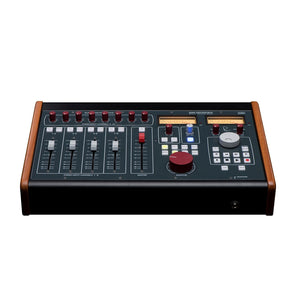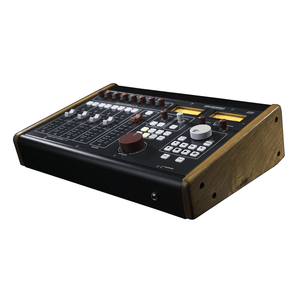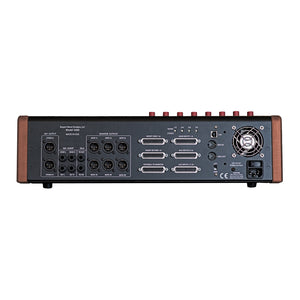Your Cart is Empty
Order Online or Choose Click & Collect - FREE Shipping on most orders over $100
Menu
-
- Computer Audio
- Studio Gear
- Instruments
- Monitoring
- DJ
- Live Sound
- Video
- SALE
-
- News
- New Arrivals
- Sign Up to our Newsletter
- About Us
- Contact Us
- CLEARANCE
- OPEN BOX
- Brands
- Cable Clearance
- SUPER SALE
- 1300 13 0202
- Login

Order Online or Choose Click & Collect - FREE Shipping on most orders over $100
$16,499.00$16,998.00
RUP-5060CP-S
Rupert Neve Designs 5060 Centerpiece with Shelford Blue Faceplate
From the pioneer of recording consoles comes the 5060 Centerpiece: the Class-A analog heart of your 21st-century studio. Sized for your desktop, the 5060 delivers the tonality and center section features of Rupert’s flagship 5088 console at your fingertips, cementing outboard together with serious custom transformers, flexible monitoring, DAW transport controls, and the raw power of a Rupert Neve-designed 24×2 mix-buss.
Type: Analog Mixers
Features
New Class-A Topologies
The new +/- 24V class-A topologies in the 5060 are the key to a more detailed, sweeter and spacious mix buss. With zero crossover distortion and unmatched purity, the 5060 delivers the sound of the 5088 to your desktop. To get more dynamic harmonic content out of the mix buss, you can push the levels on the input channels into the mix buss to find the “sweet spot”.
Custom Transformers
Beyond providing ground-loop free interfacing, Rupert’s custom transformers in the 5060 are responsible for its larger than life sound. To accentuate the classic tone from the output transformers, you can use the Silk / Texture controls to dial in the desired amount of “color” depending on what each mix needs.
Stereo Input Channels 1-8
A professional grade 100mm fader determines the level of stereo input channels 1-8, with up to +10dB of additional line gain. Channels 1-8 can be either stereo or center-panned mono, and have both mute switches and inserts. The insert send of channels 1-2, and 3-4 has optional talkback assignment for use when feeding channels 1-8 through the 5060 to multichannel cue systems. The insert sends on channels 1-8 may also be used as a pre-fader send to a multi-track recorder.
Stereo Inputs Channels 9-24
Eight active stereo inputs with rotary faders for stem and aux inputs.
Stereo Buss Master
A 100mm stereo fader provides level control for the master stereo buss, outputting to both the stereo buss monitor signal and the stereo master output. For adding compression and EQ to the mix buss, there is also a transformer-coupled insert engaged by the Insert switch.
Texture & Silk Red / Blue
Every mix demands its own treatment. Continuously variable Texture controls with Silk Red and Silk Blue modes allow the engineer to fine-tune the harmonic ratio and tonality of the 5060’s outputs – or to leave each mix pristine and uncolored. The Silk Red mode accentuates the transformer saturation in the highs and high-mid frequencies to add a “sparkle” to the mix, while Silk Blue accentuates the saturation of the lows and low-mid frequencies to add thickness and density – especially useful for dry, somewhat anemic mixes. Unlike EQ, these Silk & Texture controls saturate the output transformers, and add musical harmonics to the source material according to the amount of Texture applied.
Drive the mix buss hard and crank the Texture knob for a rich, saturated, vintage vibe – or disengage Silk entirely for clear, wide-open sonic beauty.
Talkback
The included talkback mic is activated by depressing the Talkback switch. The Talkback has level control, a direct out, and assignment to insert sends 1-2 & 3-4. When the talkback switch is depressed, the speaker output levels are lowered according to the setting of the Dim control. A talkback remote may also be plugged into the ¼” talkback remote input on the back of the 5060.
Transport Controls
Standard transport functions in DAWs including play, stop, record, fast-forward, rewind, loop, shuttle / jog and marker drop are controlled through MIDI or USB interconnection.
Monitor Source Selection
Selects the monitor source from between the stereo buss and three external monitor inputs.
Monitor Select
Selects which speaker output is active. By holding the Mon 3 button, the Mon 3 outs will “latch” on, allowing both Mon 1 & 2 for use with subwoofers or speakers in the cutting room.
Headphone Amplifier
A class-A reference-grade headphone amplifier with headphone level control. The headphone signal follows the selection of the monitor select.
Monitor Level
A precision 21-step attenuator provides highly accurate left/right stereo tracking, perfect repeatability, and determines the level of the monitor output.
Meters
VU meters display the RMS signal level of the selected monitor source, and the peak indicator illuminates red when the peak threshold has been exceeded.
Dim
Engaged when either the Dim or Talkback switch is depressed, Dim reduces the monitor volume between -6dB and -30dB.





